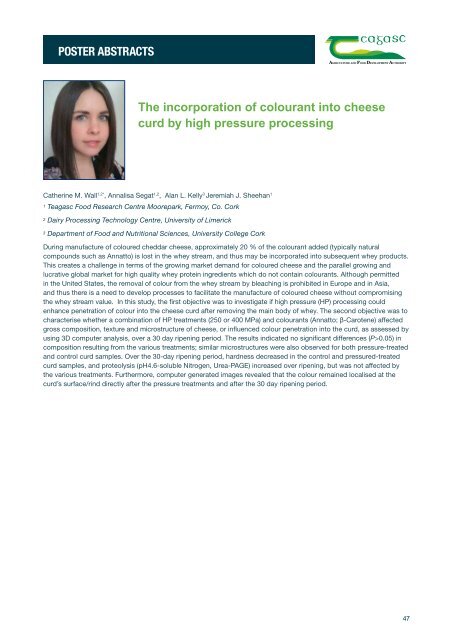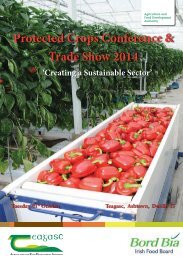FellowshipS Seminar 2016
2fFF9y9
2fFF9y9
You also want an ePaper? Increase the reach of your titles
YUMPU automatically turns print PDFs into web optimized ePapers that Google loves.
Poster ABSTRACTS<br />
The incorporation of colourant into cheese<br />
curd by high pressure processing<br />
Catherine M. Wall 1,2* , Annalisa Segat 1,2 , Alan L. Kelly 3 Jeremiah J. Sheehan 1<br />
1 Teagasc Food Research Centre Moorepark, Fermoy, Co. Cork<br />
2 Dairy Processing Technology Centre, University of Limerick<br />
3 Department of Food and Nutritional Sciences, University College Cork<br />
During manufacture of coloured cheddar cheese, approximately 20 % of the colourant added (typically natural<br />
compounds such as Annatto) is lost in the whey stream, and thus may be incorporated into subsequent whey products.<br />
This creates a challenge in terms of the growing market demand for coloured cheese and the parallel growing and<br />
lucrative global market for high quality whey protein ingredients which do not contain colourants. Although permitted<br />
in the United States, the removal of colour from the whey stream by bleaching is prohibited in Europe and in Asia,<br />
and thus there is a need to develop processes to facilitate the manufacture of coloured cheese without compromising<br />
the whey stream value. In this study, the first objective was to investigate if high pressure (HP) processing could<br />
enhance penetration of colour into the cheese curd after removing the main body of whey. The second objective was to<br />
characterise whether a combination of HP treatments (250 or 400 MPa) and colourants (Annatto; β-Carotene) affected<br />
gross composition, texture and microstructure of cheese, or influenced colour penetration into the curd, as assessed by<br />
using 3D computer analysis, over a 30 day ripening period. The results indicated no significant differences (P>0.05) in<br />
composition resulting from the various treatments; similar microstructures were also observed for both pressure-treated<br />
and control curd samples. Over the 30-day ripening period, hardness decreased in the control and pressured-treated<br />
curd samples, and proteolysis (pH4.6-soluble Nitrogen, Urea-PAGE) increased over ripening, but was not affected by<br />
the various treatments. Furthermore, computer generated images revealed that the colour remained localised at the<br />
curd’s surface/rind directly after the pressure treatments and after the 30 day ripening period.<br />
47




